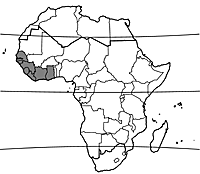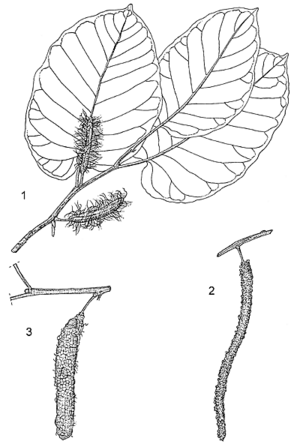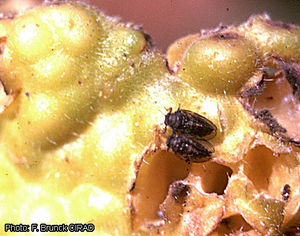Milicia regia (PROTA)
Introduction |
| General importance | |
| Geographic coverage Africa | |
| Geographic coverage World | |
| Fruit | |
| Dye / tannin | |
| Medicinal | |
| Timber | |
| Fuel | |
| Ornamental | |
| Food security | |
| Conservation status | |
Milicia regia (A.Chev.) C.C.Berg
- Protologue: Bull. Jard. Bot. Etat 52: 227 (1982).
- Family: Moraceae
Synonyms
- Chlorophora regia A.Chev. (1912).
Vernacular names
- Iroko, rock elm, African teak, African oak (En).
- Iroko, teck d’Afrique, teck kambala (Fr).
- Amoreira, moreira, tumbiro (Po).
Origin and geographic distribution
Milicia regia is indigenous to the forest zone of West Africa, from Senegal and Gambia to Ghana. It has been introduced into Nigeria and South Africa.
Uses
The wood of Milicia regia and the closely related Milicia excelsa (Welw.) C.C.Berg are not distinguished in the timber trade, and are traded under the trade name ‘iroko’, or ‘odum’ in Ghana. Iroko is a highly valued commercial timber in Africa, for which demand is large. It is used for construction work, shipbuilding and marine carpentry, sleepers, sluice gates, framework, trucks, draining boards, outdoor and indoor joinery, stairs, doors, frames, garden furniture, cabinet work, panelling, flooring and profile boards for decorative and structural uses. It is also used for carving, domestic utensils, musical instruments and toys. As it is resistant to acids and bases, it is used for tanks and barrels for food and chemical products and for laboratory benches. It is used as sliced veneer but only rarely as rotary veneer. The wood is also used as firewood and for making charcoal.
The fruit of Milicia regia is edible and is sometimes sold on markets in Ghana. The bark is used for dyeing leather and cloth. The latex is used as a glue, and has been used as an adulterant in rubber. The latex is credited with antiseptic and healing properties and is applied on wounds and burns. Other plant parts probably have similar medicinal uses as those of Milicia excelsa. Milicia regia is often considered a sacred tree.
Production and international trade
Milicia regia and Milicia excelsa are both traded as iroko, a major timber in international trade, and the share of Milicia regia in that commerce is unknown. During the 1960s Côte d’Ivoire exported about 55,000 m³ of iroko logs and 6000 m³ of iroko sawnwood per year, and Ghana 28,000 m³ of sawnwood. In 1973 Côte d’Ivoire exported as much as 136,500 m³ of logs and 16,000 m³ of sawnwood. In 1994 Ghana exported at least 47,000 m³ of sawnwood. In 2003 Ghana exported 8000 m³ of iroko sawnwood (US$ 754/m³). Exportation of iroko logs is now forbidden in Côte d’Ivoire and Ghana, but export of sawnwood is allowed.
Properties
The heartwood of Milicia regia is pale yellow to brown, darkening on exposure; it is clearly demarcated from the 5–7.5 cm wide paler sapwood. The grain is interlocked, texture medium to coarse. The wood has a strong mint-like odour and a slightly oily feel.
The wood has a density of 560–710 kg/m³ at 12% moisture content. Shrinkage rates from green to oven dry are 2.5–3.7% radial and 4.3–5.9% tangential. The wood seasons well, without warping or splitting. Movement in service is small.
At 12% moisture content, the modulus of rupture is 59–123 N/mm², modulus of elasticity 7450–9810 N/mm², compression parallel to grain 37–59 N/mm², cleavage 13.9–16.4 N/mm, Janka side hardness 3785 N, and Janka end hardness 4845 N.
The wood is easy to saw and to work with hand and machine tools. It contains, however, hard deposits (‘iroko stones’, mainly consisting of calcium carbonate), which can blunt cutting edges. In planing, the interlocked grain may cause some tearing, but this can be avoided by using cutting angles of 15° or less. The wood holds nails well, but nailing may cause some splitting. It finishes well, but filler is needed. It glues easily.
The wood is very durable. The heartwood is resistant to pinhole borer attack, and only slightly susceptible to marine borers and termites. It is resistant to fungal attack. The sapwood is liable to attack by Lyctus beetles. The heartwood is impermeable to preservatives, but the sapwood is permeable.
The wood and sawdust may cause dermatitis, irritation to nose and throat, and asthmatic reactions. The heartwood contains 2,3’,4,5’-tetrahydroxystilbene, which plays a role in the darkening of the wood on exposure.
Adulterations and substitutes
The wood properties of the two Milicia species are similar to those of teak.
Description
- Large, dioecious tree up to 35(–45) m tall; bole usually straight and cylindrical, often branchless for more than 20 m, up to 2 m in diameter, without buttresses, but spurs may become very large and extend into long surface roots; outer bark dark brown to black or grey, inner bark spongy, exuding a white latex.
- Leaves distichously alternate, simple; stipules free, slightly clasping the stem, up to 3.5 cm × 1.5 cm, caducous; petiole 1–3.5(–6) cm long; blade oblong to elliptical, 4–20(–28) cm × 3–14 cm, base obtuse to cordate, often unequal, apex shortly acuminate, margin almost entire but wavy or toothed towards the apex, papery to thinly leathery, above glabrous or nearly so, below glabrous but sparsely hairy on the veins, pinnately veined with 6–11 pairs of lateral veins.
- Inflorescence a catkin, usually solitary in leaf axils or on leafless nodes at the base of twigs, white hairy, flowers numerous in longitudinal rows alternating with rows of bracts; male inflorescence 8–20 cm × 0.5–1 cm, hanging, peduncle 1–2 cm long; female inflorescence 1–8 cm × 0.5–1.5 cm, peduncle 0.5–1.5 cm long.
- Flowers unisexual, 4-merous, sessile; male flowers c. 1.5 mm long, tepals 4, basally fused, stamens 4 and inflexed in bud, rudimentary pistil present; female flowers 2–3 mm long, with 4 basally fused tepals, ovary superior, c. 1 mm long, 1-celled, stigma 1, 8–10 mm long, sometimes a second stigma up to 1 mm long.
- Fruit an achene 2.5–3 mm long, arranged in infructescence 5–8 cm × 1.2–2 cm.
- Seed c. 2 mm long, pale brown.
- Seedling with epigeal germination.
Other botanical information
Milicia comprises 2 species, Milicia regia and Milicia excelsa, both in tropical Africa. The 2 species mainly differ in the venation and hairiness of the leaves.
Anatomy
Wood-anatomical description (IAWA hardwood codes):
- Growth rings: 2: growth ring boundaries indistinct or absent.
- Vessels: 5: wood diffuse-porous; 13: simple perforation plates; 22: intervessel pits alternate; (23: shape of alternate pits polygonal); 27: intervessel pits large (≥ 10 μm); (30: vessel-ray pits with distinct borders; similar to intervessel pits in size and shape throughout the ray cell); 31: vessel-ray pits with much reduced borders to apparently simple: pits rounded or angular; 32: vessel-ray pits with much reduced borders to apparently simple: pits horizontal (scalariform, gash-like) to vertical (palisade); 43: mean tangential diameter of vessel lumina ≥ 200 μm; 46: ≤ 5 vessels per square millimetre; 56: tyloses common.
- Tracheids and fibres: 61: fibres with simple to minutely bordered pits; 66: non-septate fibres present; 69: fibres thin- to thick-walled.
- Axial parenchyma: 80: axial parenchyma aliform; 81: axial parenchyma lozenge-aliform; (82: axial parenchyma winged-aliform); 83: axial parenchyma confluent; (85: axial parenchyma bands more than three cells wide); (91: two cells per parenchyma strand); 92: four (3–4) cells per parenchyma strand; 93: eight (5–8) cells per parenchyma strand.
- Rays: 98: larger rays commonly 4- to 10-seriate; 106: body ray cells procumbent with one row of upright and/or square marginal cells; 115: 4–12 rays per mm.
- Secretory elements and cambial variants: 132: laticifers or tanniferous tubes.
- Mineral inclusions: 136: prismatic crystals present; 137: prismatic crystals in upright and/or square ray cells; 141: prismatic crystals in non-chambered axial parenchyma cells; (154: more than one crystal of about the same size per cell or chamber).
Growth and development
Seeds normally germinate 2–4 weeks after sowing. Trees are leafless for a short period during the dry season. Flowering begins in December and may continue until March, but in Guinea and Senegal until June. It takes 5–6 weeks from fertilization to fruit maturation. Fruits are available from February onwards. Seed dispersal is mostly by birds, bats and squirrels.
Milicia regia was introduced into Nigeria from Sierra Leone: in Sapoba, on sandy soils and with 2000–2500 mm rain per year, 4-year-old trees were 9 m tall with a stem diameter of 13 cm, whereas in Ibadan, on coarse sand and gravel and with 1000–1500 mm rainfall, 4-year-old trees were only 2.5 m tall and of bad form.
Ecology
Milicia regia occurs at lower altitudes in rainforest, but is also often found as a lone tree in cultivated areas. It demands intense light and does not tolerate deep shade. In young secondary forest it cannot compete with the climbers and shrubs. Milicia regia is considered to be more water demanding and less drought-resistant than Milicia excelsa. In Côte d’Ivoire and Liberia Milicia regia occurs preferentially in the wetter coastal belt and Milicia excelsa in the drier hinterland. Milicia regia does not tolerate impeded drainage.
Propagation and planting
Milicia regia is mostly propagated by seed. The seeds are sown in nursery beds and transplanted into pots. Seeds normally germinate well. About 4 months after germination the seedlings are around 30 cm tall and ready for planting out in the field. Young plants transplant well. Milicia regia can also be propagated vegetatively by stem and root cuttings, grafting, layering and in-vitro tissue culture.
Management
Milicia regia is mostly extracted from natural forest, as plantations are often severely affected by pest problems. It coppices well.
Diseases and pests
The major constraint on the cultivation of Milicia excelsa and Milicia regia are gall-forming Phytolyma spp. (iroko gall flies). Attack leads to the formation of galls on the shoots, followed by dieback of foliage down to the woody tissue. This disrupts physiological processes, causes growth reduction, and in many cases kills seedlings. Mature leaves are not seriously affected. Efforts to control this pest have had little success, but the development or selection of more resistant Milicia genotypes may offer prospects. It has been reported that Milicia regia raised in Nigeria from seeds from Sierra Leone resists attacks by the local Phytolyma gall fly.
Genetic resources
Exploitation is often unsustainable: in the 1980s the extraction rate of iroko (Milicia regia and Milicia excelsa) in Ghana was estimated to be about 173,000 m³ per year, whereas the regeneration rate was estimated to be only about 29,000 m³ per year. Milicia regia is classified as vulnerable in the 2006 IUCN Red list of threatened species, due to excessive exploitation. It is considered a priority for in situ conservation. As genetic diversity within populations is low, but diversity between populations large, it is recommended that different populations are included in in-situ conservation efforts. Milicia regia is legally protected in Gambia. In Ghana a special permit is needed for its exploitation.
Breeding
Partial genetic resistance to Phytolyma within natural Milicia populations has been identified, which may lead to the development of resistant lines for vegetative propagation. Selection work is underway in Ghana.
Prospects
Milicia regia belongs to the most valuable commercial timber trees of Africa, due to its attractive appearance, durability, stability and good working properties of the wood. At present, however, its exploitation is not sustainable. It requires protection and exploitation has to be limited if it is to become sustainable. Plantation is difficult due to a pest problem. The identification of sources of resistance to the iroko gall fly deserves high priority, possibly complemented by the development of effective control methods.
Major references
- Berg, C.C., 1977. Revisions of African Moraceae (excluding Dorstenia, Ficus, Musanga and Myrianthus). Bulletin du Jardin Botanique National de Belgique 47(3–4): 267–407.
- Berg, C.C., 1982. The reinstatement of the genus Milicia Sim (Moraceae). Bulletin du Jardin Botanique National de Belgique 52(1–2): 225–229.
- Berhaut, J., 1979. Flore illustrée du Sénégal. Dicotylédones. Volume 6. Linacées à Nymphéacées. Gouvernement du Sénégal, Ministère du Développement Rural et de l’Hydraulique, Direction des Eaux et Forêts, Dakar, Senegal. 636 pp.
- Bolza, E. & Keating, W.G., 1972. African timbers: the properties, uses and characteristics of 700 species. Division of Building Research, CSIRO, Melbourne, Australia. 710 pp.
- Burkill, H.M., 1997. The useful plants of West Tropical Africa. 2nd Edition. Volume 4, Families M–R. Royal Botanic Gardens, Kew, Richmond, United Kingdom. 969 pp.
- Cobbinah, J.R. & Wagner, M.R., 1995. Phenotypic variation in Milicia excelsa to attack by Phytolyma lata (Psyllidae). Forest Ecology and Management 75(1–3): 147–153.
- Ofori, D.A., Swaine, M.D., Leifert, C., Cobbinah, J.R. & Price, A.H., 2001. Population genetic structure of Milicia species characterised by using RAPD and nucleotide sequencing. Genetic Resources and Crop Evolution 48: 637–647.
- Savill, P.S. & Fox, J.E.D., 1967. Trees of Sierra Leone. Forest Department, Freetown, Sierra Leone. 316 pp.
- UNEP-WCMC, 2006. Contribution to an evaluation of tree species using the new CITES Listing Criteria. UNEP World Conservation Monitoring Centre, Cambridge, United Kingdom. [Internet]. http://www.unep-wcmc.org/species/tree_study/contents1_en.htm. September 2006.
- Voorhoeve, A.G., 1965. Liberian high forest trees. A systematic botanical study of the 75 most important or frequent high forest trees, with reference to numerous related species. Pudoc, Wageningen, Netherlands. 416 pp.
Other references
- African Regional Workshop (Conservation & Sustainable Management of Trees, Zimbabwe), 1998. Milicia regia. In: IUCN. 2006 Red list of threatened species. [Internet] http://www.iucnredlist.org. August 2006.
- Aubréville, A., 1959. La flore forestière de la Côte d’Ivoire. Deuxième édition révisée. Tome premier. Publication No 15. Centre Technique Forestier Tropical, Nogent-sur-Marne, France. 369 pp.
- CAB International, 2005. Forestry Compendium. Milicia regia. [Internet] http://www.cabicompendium.org/fc/datasheet.asp?CCODE=MILIRE&COUNTRY=0. September 2006.
- FAO, 1984. Report of the fifth session of the FAO panel of experts on forest gene resources information, 8–11 December 1981, Rome, Italy. FAO, Rome, Italy. 106 pp.
- Farmer, R.H., 1972. Handbook of hardwoods. 2nd Edition. Her Majesty’s Stationery Office, London, United Kingdom. 243 pp.
- Ganda, K.J. & Wright, E.H.M., 1992. The chemical nature and adhesive properties of gums and resins from some West African plants. Part 2. African Journal of Science and Technology, Series B: Science, 6(1): 21–31.
- Hawthorne, W.D., 1995. Ecological profiles of Ghanaian forest trees. Tropical Forestry Papers 29. Oxford Forestry Institute, Department of Plant Sciences, University of Oxford, United Kingdom. 345 pp.
- Irvine, F.R., 1961. Woody plants of Ghana, with special reference to their uses. Oxford University Press, London, United Kingdom. 868 pp.
- Keay, R.W.J., 1958. Moraceae. In: Keay, R.W.J. (Editor). Flora of West Tropical Africa. Volume 1, part 2. 2nd Edition. Crown Agents for Oversea Governments and Administrations, London, United Kingdom. pp. 593–616.
- Keay, R.W.J., 1989. Trees of Nigeria. A revised version of Nigerian trees (1960, 1964) by R.W.J. Keay, C.F.A. Onochie and D.P. Stanfield. Clarendon Press, Oxford, United Kingdom. 476 pp.
- Morgan, J.W.W. & Orsler, R.J., 1968. The chemistry of color changes in wood. I. The significance of stilbenes. Holzforschung 22(1): 11–16.
- Nyong’o, R.N., Cobbinah, J.R. & Appiah-Kwarteng, J., 1994. Flowering and fruiting patterns in Milicia excelsa and Milicia regia Welw. Ghana Journal of Forestry 1: 19–29.
- Ofori, D.A., 2001. Genetic diversity and its implications for the management and conservation of Milicia species. PhD thesis, University of Aberdeen, United Kingdom. 158 pp.
- Ofori, D.A. & Cobbinah, J.R., 1999. Manual for vegetative propagation of iroko (odum, Milicia excelsa). Soronko Printing Press, Kumasi, Ghana. 44 pp.
- Ofori, D.A., Cobbinah, J.R. & Appiah-Kwarteng, J., 2001. Genetic variation, heritability and expected genetic gains in Milicia excelsa (iroko). Journal of Tropical Forest Science 13(2): 344–361.
- Ofori, D.A., Swaine, M.D., Cobbinah, J.R. & Price, A.H., 2003. Genetic diversity and biodiversity conservation guidelines for Milicia species in Ghana. Ghana Journal of Forestry 11(2): 27–38.
- Takahashi, A., 1978. Compilation of data on the mechanical properties of foreign woods (part 3) Africa. Shimane University, Matsue, Japan, 248 pp.
- Taylor C.J., 1960. Synecology and sylviculture in Ghana. Thomas Nelson and Sons, Edinburgh, United Kingdom. 418 pp.
- Taylor, D.A.R., Kankam, B.O. & Wagner, M.R., 2000. The role of the fruit bat, Eidolon helvum, in seed dispersal, survival and germination in Milicia excelsa, a threatened West African hardwood. In: Cobbinah, J.R. & Wagner, M.R. (Editors). Research advances in restoration of iroko as a commercial species in West Africa. Forestry Research Institute of Ghana, Kumasi, Ghana. pp. 29–39.
- White, M.G., 1966. The problem of the Phytolyma gall bug in the establishment of Chlorophora. Institute Paper No 37. Commonwealth Forestry Institute, University of Oxford, Oxford, United Kingdom. 52 pp.
Sources of illustration
- Berg, C.C., 1977. Revisions of African Moraceae (excluding Dorstenia, Ficus, Musanga and Myrianthus). Bulletin du Jardin Botanique National de Belgique 47(3–4): 267–407.
- Berhaut, J., 1979. Flore illustrée du Sénégal. Dicotylédones. Volume 6. Linacées à Nymphéacées. Gouvernement du Sénégal, Ministère du Développement Rural et de l’Hydraulique, Direction des Eaux et Forêts, Dakar, Senegal. 636 pp.
- Voorhoeve, A.G., 1965. Liberian high forest trees. A systematic botanical study of the 75 most important or frequent high forest trees, with reference to numerous related species. Pudoc, Wageningen, Netherlands. 416 pp.
Author(s)
- D.A. Ofori, Forestry Research Institute of Ghana (FORIG), University P.O. Box 63, KNUST, Kumasi, Ghana
Correct citation of this article
Ofori, D.A., 2007. Milicia regia (A.Chev.) C.C.Berg. In: Louppe, D., Oteng-Amoako, A.A. & Brink, M. (Editors). PROTA (Plant Resources of Tropical Africa / Ressources végétales de l’Afrique tropicale), Wageningen, Netherlands. Accessed 18 December 2024.
- See the Prota4U database.







